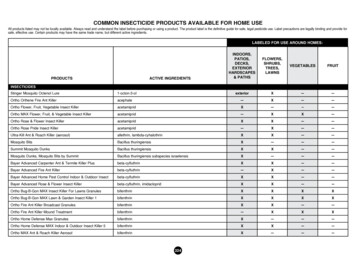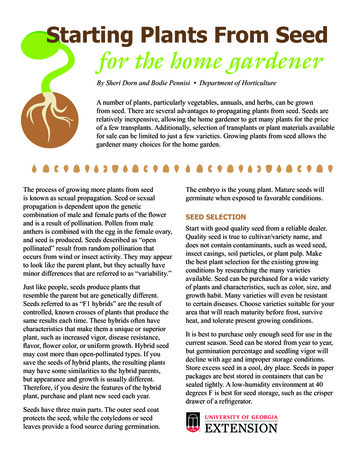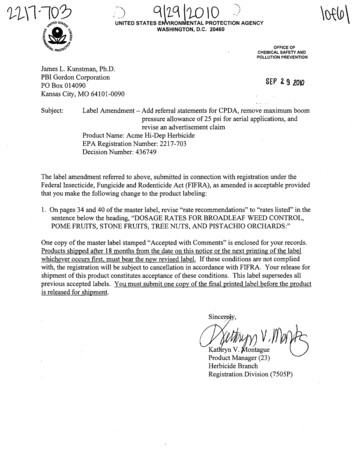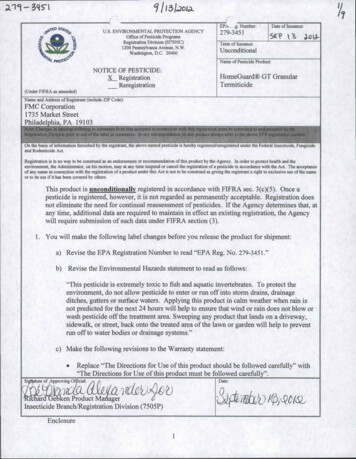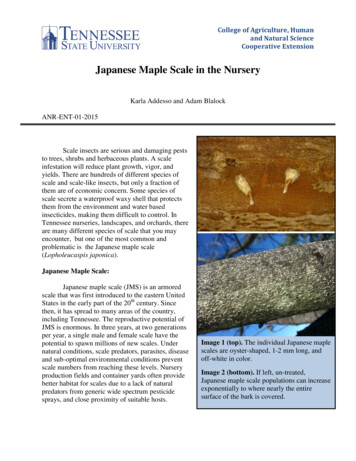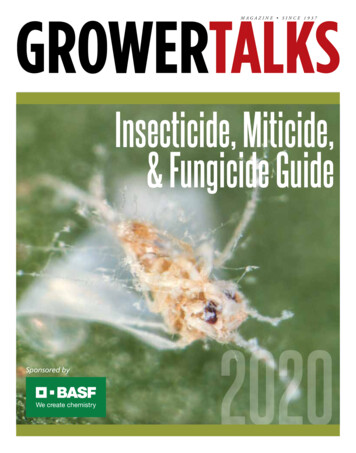
Transcription
MAGAZINE SINCE 1937Insecticide, Miticide,& Fungicide GuideSponsored by2020
PRECISIONTA R G E T E Dfor piercing-sucking insectsThe threat of pests is constantly on the mind of grower s, and they needsolutions that are precise, ef fective and suppor t sustainable growingpractices. Now, there’s an answer. Ventigra Insecticide controls both Qand B biot ypes of whiteflies. It uses an innovative mode of action that deliver stargeted control of piercing and sucking insects while having minimal impact onbeneficial insects, including predator y mites. The result: high- qualit y plants.Always read and follow label directions.Ventigra insecticide may not be registered for sale or use in all states. Please check with your state or local Extension Service.Refer to label for registered uses. It is a violation of Federal law to use a product in a manner inconsistent with its labeling.Ventigra is a trademark of BASF. 2019 BASF Corporation. All rights reserved.
EDITORIALChris Beytesbeytes@growertalks.comEDITORJennifer ZurkoRETAIL EDITOR Jennifer PolanzEDITOR-AT-LARGE Ellen C. WellsSTAFF EDITOR Allison WestbrookMANAGING EDITORCOLUMNISTSAustin Bryant, Dr. Brian Corr, Albert Grimm,Heather Hydoski, Roger McGaughey,Amy Morris, Art Parkerson, Paul Pilon,Bill Swanekamp, Abe VanWingerdenCONTRIBUTING WRITERSAnne-Marie Hardie, Society of American Florists,AmericanHort, Griffin Technical ServicesKathy WoottonChris TruesdalePHOTOGRAPHER Mark WidhalmCOPY EDITOR Sue OlsenPRODUCTION MANAGERCREATIVE DIRECTORSALES866.888.4237Paul Blackpblack@ballpublishing.comPUBLISHER, SALES MANAGERACCOUNT MANAGER Kim Brownkbrown@ballpublishing.comAdriana Heikkilaaheikkila@ballpublishing.comSALES ASSISTANTCUSTOMER SERVICEAllison WestbrookCLASSIFIED ADVERTISINGclassifieds@ballpublishing.comA Friend RememberedG. Victor Ball, Editor from 1949 -1997GrowerTalks general offices are located at:PO BOX 1660, West Chicago, Illinois 60186 U.S.A.PH: 630.231.3675 FAX: 630.231.5254TOLL-FREE: 1-888-888-0013www.growertalks.comGrowerTalks (ISSN 0276-9433) is published monthly byBall Publishing, PO Box 1660, West Chicago, Illinois 60186, UnitedStates. Subscriptions are free to qualified readers in the US.Subscription price for non-qualified readers is 35 per year US andCanada. All other foreign subscriptions must pay 99/year toreceive/continue to receive GrowerTalks and Green Profit.GrowerTalks is a registered trademark of Ball Horticultural Companyin the U.S. Periodicals postage paid at West Chicago, IL and atadditional mailing offices. Postmaster: send address changes toGrowerTalks Magazine, PO Box 1660, West Chicago, Illinois 60186,United States. 2019 GrowerTalks Magazine. All rights reserved.Posted under Canada publications mail agreement #40732015.Canada returns to be sent to International Delivery Solutions, POBox 456, Niagara Falls, ON L2E 6V2, Canada.Printed in the U.S.A.Welcome to the 2020 edition of the Insecticide,Miticide & Fungicide (IMF) Guide! One of the mostexciting things about my role as a Product Manager is launching new and innovative products intothe commercial greenhouse and nursery market.Newly introduced in 2019, the latest BASF offerings are complementary insecticide solutions—Ventigra insecticide and Velifer fungal contactinsecticide/miticide—targeting the range of themost important piercing-sucking insects and mite pests. They now jointhe ranks of Sultan miticide, and Nemasys and Millenium beneficialnematodes that readily integrate into grower IPM programs, while allowing beneficial insects and pollinators to thrive.We’re building on our commitment to be the leading manufacturerwith an outstanding team to support the industry. The articles and content in this edition of the IMF Guide touch on those ideas: integration ofcontrols and best practices alongside optimization of growing conditions.In 2019, BASF is celebrating its 10th anniversary of the introduction of Intrinsic brand fungicides, delivering a decade of outstanding,broad-spectrum disease control and a foundation for effective resistancemanagement programs. Pageant Intrinsic brand fungicide, Empress Intrinsic brand fungicide and Orkestra Intrinsic brand fungicide comprise the original EPA-registered fungicide brands to demonstrate specificplant health benefits. Over the past decade, growers have come to learn,understand and experience firsthand the results gained from greaterstress tolerance and increased growth efficiency—producing stronger,denser roots and leading to more consistent, higher-quality plants.The future is bright. BASF is continuing to invest in the developmentof more innovative ornamental crop protection tools, combining the bestof conventional and biological pest management approaches. Altogether,BASF is delivering comprehensive resistance management solutions formaximum grower confidence, superior horticultural crops, and compatibility with pollinators and beneficials.We wish you success in the coming 2020 season.Joe LaraSr. Product ManagerGreenhouse & Nursery ProductionBASF—Professional & Specialty SolutionsGreenProfit Supplement EnclosedOn the cover: A silverleaf whitefly (Bemisia tabaci) being infected with Velifer fungal contactinsecticide/miticide.Disclaimer: These recommendations may not be appropriate for conditions in all states and may not comply with laws and regulations inevery state. These recommendations were current as of July 2019. Individuals who use agricultural chemicals are responsible for ensuringthat the intended use complies with current regulations and conforms to the product label. Be sure to obtain current information aboutusage regulations and examine a current product label before purchasing or applying any chemical. For assistance, contact your countyCooperative Extension Agent or pest control advisor. The use of brand names and any mention or listing of commercial products or servicesin this publication does not imply endorsement by Ball Publishing.
Plant Protection:How to Use Pesticides AppropriatelyRaymond A. Cloyd, Kansas State UniversityPlant protection (formerly integrated pest management orIPM) is designed to alleviate or manage insect and mite pestpopulations of greenhouse and nursery-grown horticultural crops by using a variety of strategies, including scouting,cultural, physical, pesticidal and biological.The primary means of managing insect and mite pestpopulations is still the use of pesticides, in this case, insecticides and miticides. Pesticide applications are conducted tosuppress existing insect and mite pest populations in order toprevent or reduce plant damage. Therefore, it’s important toexercise proper stewardship when using pesticides.This article provides information on the factors that mustbe considered when selecting and applying insecticides andmiticides to manage pest populations.1. Correctly identify insect and mite pests. Proper identification of insect and mite pests is essential in selecting theappropriate pesticide because many selective pesticides havea narrow range of activity on specific insect and mite pests.There are a number of commercially available pesticides thatare only labeled for use on one pest group (e.g. mites), whereas other pesticides have activity on two different insect types(e.g. aphids and thrips) or insects and mites (e.g., thrips andmites). Always have several reference publications availablethat contain clear images or pictures of the actual insect andmite pest, and plant damage that will help you to correctlyidentify the pest problem.2. Thoroughly cover all plant parts with spray solutions.When using contact pesticides, it’s important to thoroughlycover all plant parts, including leaves, flowers, stems, andfruits (Figure 1). The life stages (egg, larva, nymph, pupa oradult) of almost all insect and mite pests are located on theleaf underside to avoid desiccation (loss of moisture) fromultra-violet light. Therefore, coverage of leaf undersides isimportant in contacting and killing insect and mite pests.When plants are small, it’s easier to cover all plant parts,resulting in higher mortality of insect and mite pests. However, when the plant architecture (number of leaves andbranches) is more complex (Figure 2) insects such as thripsand mealybugs can escape exposure from insecticide spraysbecause there are more hiding places. In addition, it’s moredifficult to cover the surface area of the entire plant. Therefore, more time must be spent spraying each plant to ensurethorough coverage. The use of a surfactant may be requiredto enhance coverage. A surfactant reduces the surface tension of spray droplets, allowing for better coverage of the leafsurface.3. Time pesticide applications accordingly. Insecticidesand miticides (pesticides) should be applied when the mostsusceptible life stage of a giveninsect or mite pest is present.The most susceptible life stagesto many pesticides, in general, are the larva, nymph andadult. The egg and pupa areless susceptible to pesticides.Also, pesticide applicationsshould be conducted in theearly morning or late afternoonwhen most insect and mitepests are active.Moreover, informationobtained from scouting willhelp time applications becausescouting determines populationdynamics (the change of insectand mite pest populations overtime based on environmentalfactors) and when the mostsusceptible life stages arepresent. This information willensure high mortality levels ofFigure 1. When using contactpesticides, it’s important tothoroughly cover all plant parts,including leaves, flowers, stems,and fruits.4GROWERTALKS 2020 Insecticide, Miticide & Fungicide Guide
insect and mite pest populationsfollowing applications, whichwill help prevent outbreaks fromoccurring.4. Monitor water quality.Water quality is very importantin enhancing plant growth anddevelopment, however, waterquality—especially pH andhardness—may also influencethe effectiveness of insecticidesand miticides.For example, when the pH ofa spray solution is 7.0, certaininsecticides (and miticides)are susceptible to alkalinehydrolysis. Alkaline hydrolysis is a degradation process inwhich insecticide moleculesare fragmented when the waterpH is 7.0. Insecticides in thechemical class organophosphate(e.g., acephate and chlorpyrifos)are very sensitive to alkalinehydrolysis. A spray solutionwater pH between 5.8 and 7.0should be maintained to avoidalkaline hydrolysis. Always readFigure 2. When the plant architecture is more complex insects such as thrips and mealybugs can escapethe product label for informaexposure from insecticide sprays because there are more hiding places.tion associated with appropriatespray solution pH.5. Rotate pesticides with different modes of action. Rotatapplications are needed when simultaneously dealing withing pesticides with different modes of action will reduce themultiple age structures or over-lapping generations.potential for resistance developing in insect or mite pest popApplication frequency depends on the residual activityulations. Mode of action refers to how a pesticide negatively(persistence) of a given pesticide and temperature, as insectaffects the metabolic or physiological processes of insect andand mite pest development (life cycle: egg to adult) increasesmite pests. In general, use the same mode of action within aunder higher temperatures, consequently requiring more frepest generation and then switch to another pesticide with aquent applications. However, more frequent applications candifferent mode of action in the next generation.result in placing undue selection pressure on insect and/orThe rotation of pesticides can vary depending on the seamite pest populations, thus increasing the potential for insectson with more frequent rotations occurring from mid-springand mite pest populations to develop pesticide resistance.through late fall (in most locations) compared to winter7. Use the proper label rate. Always read the pesticide lathrough early-spring. This is due to the effects of temperaturebel and follow specific rates accordingly to enhance pesticideon insect and mite pests, and the presence of host plants.effectiveness. In general, avoid consistently exposing pestThe pesticide label should contain the Insecticide Resistancepopulations to the highest label rate to mitigate the potenAction Committee (IRAC) mode of action designation (numtial for insect and/or mite pest populations from developingber or combination of number and letter) associated withpesticide resistance. The lowest label rate—especially earlythe active ingredient. For example, the IRAC designation foron in the crop production cycle—may be just as effective asspinosad (Conserve) is 5 and 7C for pyriproxyfen (Distance/the highest label rate. This may be due to insect or mite pestsFulcrum). For more information on the IRAC mode of actionpresent early during crop production not being exposed todesignations consult the following website:extensive use of pesticides, which may result in higher initialwww.irac-online.orgmortality levels.6. Apply pesticides frequently enough. Most commerIn conclusion, pesticide applications will be more effectivecially available pesticides used in greenhouse productionin suppressing insect and mite pest populations by followingsystems only kill the young (larva and nymph) and adult lifethe seven points discussed in this article, including:stage of insect and mite pests with minimal direct effects on1) correctly identifying insect and mite pests; 2) thoroughlythe egg and pupal life stages. Therefore, repeat or multiplecover all plant parts with spray solutions; 3) time pesticidepesticide applications are required to kill life stages that wereapplications accordingly; 4) monitor water quality; 5) rotateinitially not affected by previous pesticide applications suchpesticides with different modes of action; 6) apply pesticidesas larva and nymph that were in the egg stage, and adultsfrequently enough; and 7) use the proper label rate.that were in the pupal stage. Furthermore, more frequentGROWERTALKS 2020 Insecticide, Miticide & Fungicide Guide5
These Guys Suck!Juang Horng “JC” Chong, Clemson UniversityMany sap-sucking insect pests, such as aphids and whiteflies, plague ornamental plant production. Members of thisgroup share a unique characteristic: they all have a modifiedmouthpart that functions like a hypodermic needle. Thismodified mouth helps them pierce through plant tissues andsuck up vascular sap or cell contents.It also makes sucking insects good vectors of plant viruses,although viral transmission by sucking insects is a minorconcern in greenhouse floriculture. The major damages bysucking insects are honeydew, sooty mold, reduced plantgrowth and objectionable presence.Accurate identification of insect or mite pest species iscrucial to developing an effective management program,particularly a biological control program, because differentspecies can vary in their susceptibility to pesticides or biological control agents. “Insects and Related Pests of Flowers andFoliage Plants” sts-of-flowers-and-foliage-plants) and “Insect andMite Pests of Floriculture Crops: Identification Guide”(http://e-gro.org/books.php) from North Carolina StateUniversity are two of the many resources that can assist youin identifying your pest species.Aphids are perhaps the most common pests in greenhouse floriculture. Wingless aphids composed the majorityof the population and winged aphids (alates) are producedwhen the population is large. Melon aphid (AKA cotton aphid)and green peach aphid are the most common aphid species.Foxglove aphid (AKA glasshouse potato aphid) is becomingincreasingly common in the northeastern United States.Potato aphid is also becoming more problematic, particularlyin greenhouse vegetable production. Growers may encounteraphid species that specialized on certain crops, such as chrysanthemum aphid and rose aphid.Sweetpotato whitefly (AKA silverleaf whitefly) is themost commonly encountered whitefly species, whereas thegreenhouse whitefly and banded winged whitefly are foundoccasionally. The Q- or Mediterranean biotype of sweetpotatowhitefly is known to be resistant to several neonicotinoidsand insect growth regulators. The B- and Q-biotypes can onlybe distinguished using genetic analysis.A large population of chrysanthemum aphids can cause a large amount of sooty mold.6GROWERTALKS 2020 Insecticide, Miticide & Fungicide Guide
Many scale insect and mealybug speciescan feed on ornamental plants. Brown softscale and hemispherical scale are found occasionally. Citrus mealybug is the most common mealybug species, whereas the Madeiramealybug is commonly found in the southernU.S. Longtailed mealybug is a common pest offoliage plants. The ground or root mealybugs(Rhizoecus spp.) feed on the roots and are often detected only when the pots are removed.The key to successful biological andchemical management of sucking insectsis finding the infestation early. All suckinginsects produce a large number of offspring;as a result, the population builds up veryquickly. Catching and treating the populationin its early stage of build-up ensures bettertreatment efficacy and reduces damage andcost.Whitefly and winged aphid adults dispersing from the surrounding fields into thegreenhouse can be monitored with yellowsticky cards deployed near doors, vents andWhiteflies.side panels. Yellow sticky cards deployed justabove the canopy within the crop can also detectindividuals that are moving in or becoming active in the cropbelow. Scout the greenhouse regularly and look for signs ofinfestation, such as honeydew, sooty mold and shed skins.Randomly selected plants or those that have signs of infestation should be examined carefully for insects and mites.Treatment should begin as soon as an infestation is found.Biological control practices, such as releasing whiteflyparasitoids and deploying aphid bank plants, can be veryeffective in reducing pest populations, damage and treatmentcosts—particularly on crops that are consistently attacked bysucking insects. These biological control practices are especially effective when they’re used against small pest populations. A large number of biological control agent species areavailable against whiteflies and aphids, however, the optionsfor mealybugs and scale insects are limited.Entomopathogens or entomopathogen-derived products—such as Beauveria bassiana (Botanigard, Velifer), Isariafumosorosea (Ancora), Chromobacterium subtsugae (Grandevo)and heat-killed Burkholderia spp. (Venerate)—are availablefor sucking insect management and can be applied in thesame method as conventional insecticides. Pre-plant dips ofunrooted cuttings in a solution of 0.1% horticultural oil or acombination of 0.5% insecticidal soap and Botanigard havebeen demonstrated as an effective way of reducing whiteflypopulations on the cuttings and maintaining low whiteflypopulations for eight weeks.Insecticides registered for managing sucking insects andother insect and mite pests are listed in this pest management guide. The options available can be overwhelming. Regardless of the products selected, everyone should rememberthree general practices in managing sucking insects.First, because sucking insects generally feed under theleaves or deep within the canopy, full spray coverage mustbe achieved. Trials after trials have suggested that efficacyof insecticide spray can be improved by adding a spreader-sticker, particularly when used against insects with morewax deposits, such as whiteflies and mealybugs. And, lastly,because of the sucking insects’ short developmental time andhigh reproductive capacity, we must rotate among productsof different modes of action or IRAC groups.Traditionally, sucking insects on highly susceptible cropshave been effectively and economically controlled for an entire growing cycle with medium drench of systemic neonicotinoids (IRAC Group Number 4A), such as dinotefuran (Safari),
targeted control of piercing and sucking insects while having minimal impact on . Cooperative Extension Agent or pest control advisor. The use of brand names and any mention or listing of commercial products or services . Fulcrum). For more information on the IRAC m


